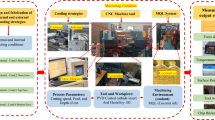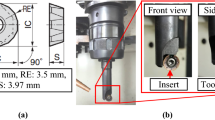Abstract
Sustainable machining in difficult-to-turn material has been aggressively researched in recent days. In this context, the various cooling systems through MQL were developed as sustainable machining. The present study aims to propose and develop a new internal and external cooling system for the tool holder to study its effectiveness during the turning of Hastelloy-B3 (HB-3). Further, the novelty of the proposed design internal design (top and bottom on the insert) is to supply the fluid at the very near end of the cutting edge and the external design (rake and nose side) is to spray the cutting fluid at the bottom of the cutting edge. The proposed design has the modification only on the shim with a micro-milled groove of 2 mm for internal cooling system arrangement with a micro-hole at the bottom of the cutting edge. The proposed design has a copper tube placed in the 2 mm groove to supply a very small quantity of fluid i.e., a small quantity lubrication concept through the MQL system. Coconut oil as a fluid for the tool holder's cooling system under two conditions: external (TD1 Rake Side Spray, TD2 Nose Side Spray) and internal (TD3 Top on Fluid Flow Face, TD4 Bottom on Fluid Flow Face). The experimental results reveal that the TD4 condition improved the tool life by 12.9%, 32.6%, and 43% compared to other conditions. The improvement in tool life is attributed to improved tool-chip contact length by 38% and 28.5% and reduced cutting force by 9.7%. For condition TD4, in-depth surface hardness values of 11% and 17.6% reduced surface integrity. At tensile improvements of 23% and 42% and compressive stress improvements of 19.8% and 36.7% in the same conditions, residual stress was seen. The roughest surface was 21.5% at TD3. Thus, sustainable new cooling systems make other hard-to-turn materials machinable.















Similar content being viewed by others
References
Yıldırım ÇV (2019) Experimental comparison of the performance of nanofluids, cryogenic and hybrid cooling in turning of Inconel 625. Tribol Int 137(April):366–378. https://doi.org/10.1016/j.triboint.2019.05.014
Li BK, Miao Q, Li M, Zhang X, Ding WF (2020) An investigation on machined surface quality and tool wear during creep feed grinding of powder metallurgy nickel-based superalloy FGH96 with alumina abrasive wheels. Adv Manuf 8(2):160–176. https://doi.org/10.1007/s40436-020-00305-2
Debnath S, Reddy MM, Yi QS (2014) Environmental friendly cutting fluids and cooling techniques in machining: a review. J Clean Prod 83:33–47. https://doi.org/10.1016/j.jclepro.2014.07.071
Yildirim ÇV, Kivak T, Sarikaya M, Şirin Ş (2020) Evaluation of tool wear, surface roughness/topography and chip morphology when machining of Ni-based alloy 625 under MQL, cryogenic cooling and CryoMQL. J Mater Res Technol 9(2):2079–2092. https://doi.org/10.1016/j.jmrt.2019.12.069
Çetindağ HA, Çiçek A, Uçak N (2020) The effects of CryoMQL conditions on tool wear and surface integrity in hard turning of AISI 52100 bearing steel. J Manuf Process 56:463–473. https://doi.org/10.1016/j.jmapro.2020.05.015
Rajaguru J, Arunachalam N (2020) A comprehensive investigation on the effect of flood and MQL coolant on the machinability and stress corrosion cracking of super duplex stainless steel. J Mater Process Technol. https://doi.org/10.1016/j.jmatprotec.2019.116417
Kadam GS, Pawade RS (2017) Surface integrity and sustainability assessment in high-speed machining of Inconel 718—an eco-friendly green approach. J Clean Prod 147:273–283. https://doi.org/10.1016/j.jclepro.2017.01.104
de Paula Oliveira G, Cindra Fonseca M, Araujo AC (2017) Analysis of residual stress and cutting force in end milling of Inconel 718 using conventional flood cooling and minimum quantity lubrication. Int J Adv Manuf Technol 92(9–12):3265–3272. https://doi.org/10.1007/s00170-017-0381-3
Binali R, Demirpolat H, Kuntoğlu M, Salur E (2023) Different aspects of machinability in turning of AISI 304 stainless steel: a sustainable approach with MQL technology. Metals (Basel) 13(6):1088. https://doi.org/10.3390/met13061088
Mallick R, Kumar R, Panda A, Sahoo AK (2023) Hard turning performance investigation of AISI D2 steel under a dual nozzle MQL environment. Lubricants. https://doi.org/10.3390/lubricants11010016
Saleem MQ, Mehmood A (2022) Eco-friendly precision turning of superalloy Inconel 718 using MQL based vegetable oils: Tool wear and surface integrity evaluation”. J Manuf Process 73(October 2021):112–127. https://doi.org/10.1016/j.jmapro.2021.10.059
Tiwari S, Amarnath M (2023) Improving the machining performance with bio-degradable coconut oil-assisted MQL turning of AISI-1040 steel: a sustainable machining approach. Biomass Convers Biorefin. https://doi.org/10.1007/s13399-023-04573-3
Zahoor S, Abdul-Kader W, Ishfaq K (2020) Sustainability assessment of cutting fluids for flooded approach through a comparative surface integrity evaluation of IN718. Int J Adv Manuf Technol 111(1–2):383–395. https://doi.org/10.1007/s00170-020-06130-y
Zaman PB, Dhar NR (2019) Design and evaluation of an embedded double jet nozzle for MQL delivery intending machinability improvement in turning operation. J Manuf Process 44(October 2018):179–196. https://doi.org/10.1016/j.jmapro.2019.05.047
Wu Z, Yang Y, Luo C (2016) Design, fabrication and dry cutting performance of pulsating heat pipe self-cooling tools. J Clean Prod 124:276–282. https://doi.org/10.1016/j.jclepro.2016.02.129
Wu Z, Xing Y, Liu L, Huang P, Zhao G (2020) Design, fabrication and performance evaluation of pulsating heat pipe assisted tool holder. J Manuf Process 50:224–233. https://doi.org/10.1016/j.jmapro.2019.12.054
Isik Y (2016) Using internally cooled cutting tools in the machining of difficult-to-cut materials based on Waspaloy. Adv Mech Eng 8(5):1–8. https://doi.org/10.1177/1687814016647888
Wu T, Li T, Ding X, Chen H, Wang L (2018) Design of a modular green closed internal cooling turning tool for applications. Int J Precis Eng Manuf Green Technol 5(2):211–217. https://doi.org/10.1007/s40684-018-0021-x
Öztürk E, Yıldızlı K, Sağlam F (2021) Investigation on an innovative internally cooled smart cutting tool with the built-in cooling-control system. Arab J Sci Eng 46(3):2397–2411. https://doi.org/10.1007/s13369-020-05002-7
Li T, Wu T, Ding X, Chen H, Wang L (2018) Experimental study on the performance of an internal cooled turning tool with topological channel. Int J Adv Manuf Technol 98(1–4):479–485. https://doi.org/10.1007/s00170-018-2278-1
Fang Z, Obikawa T (2020) Influence of cutting fluid flow on tool wear in high-pressure coolant turning using a novel internally cooled insert. J Manuf Process 56:1114–1125. https://doi.org/10.1016/j.jmapro.2020.05.028
Nazareno Fernandes GH et al (2023) Performance comparison between internally cooled tools and flood cooling during grey cast iron turning. J Manuf Process 85:817–831. https://doi.org/10.1016/j.jmapro.2022.11.040
Chen M, Peng R, Zhao L, Chen R, Luo Y (2022) Effects of minimum quantity lubrication strategy with internal cooling tool on machining performance in turning of nickel-based superalloy GH4169. Int J Adv Manuf Technol 118(11–12):3673–3689. https://doi.org/10.1007/s00170-021-08194-w
Gupta S, Venkatesan K, Devendiran S, Mathew AT (2019) Experimental investigation of IN725 under different cooling environments using new tool holder. Mater Manuf Process 34(6):637–647. https://doi.org/10.1080/10426914.2018.1532583
Shu S, Zhang Y, He Y, Zhang H (2021) Design of a novel turning tool cooled by combining circulating internal cooling with spray cooling for green cutting. J Adv Mech Des Syst Manuf. https://doi.org/10.1299/JAMDSM.2021JAMDSM0003
Peng R, Jiang H, Tang X, Huang X, Xu Y, Hu Y (2019) Design and performance of an internal-cooling turning tool with micro-channel structures. J Manuf Process 45:690–701. https://doi.org/10.1016/j.jmapro.2019.08.011
Srivathsa SSA, Muralidharan B (2023) Characterization of 3D metal printed cutting tool with transpiration cooling channels. Mater Res Express 10(10):106521. https://doi.org/10.1088/2053-1591/ad04b1
Rakesh PR, Chakradhar D (2023) Experimental investigation of hybrid cooling approach using a modified tool holder for turning of Inconel 625 superalloy. Int J Adv Manuf Technol 125(1–2):873–885. https://doi.org/10.1007/s00170-022-10781-4
Venkatesan K, Devendiran S, Murali T (2022) A hybrid algorithm for multi-objective optimisation of parameters nanofluid in MQL-turning of Inconel X-750. Adv Mater Process Technol. https://doi.org/10.1080/2374068X.2022.2129825
Eltaggaz A, Zawada P, Hegab HA, Deiab I, Kishawy HA (2018) Coolant strategy influence on tool life and surface roughness when machining ADI. Int J Adv Manuf Technol 94(9–12):3875–3887. https://doi.org/10.1007/s00170-017-1088-1
Korkmaz ME, Gupta MK, Boy M, Yaşar N, Krolczyk GM, Günay M (2021) Influence of duplex jets MQL and nano-MQL cooling system on machining performance of Nimonic 80A. J Manuf Process 69(June):112–124. https://doi.org/10.1016/j.jmapro.2021.07.039
Nimel Sworna Ross K, Manimaran G (2019) Effect of cryogenic coolant on machinability of difficult-to-machine Ni–Cr alloy using PVD-TiAlN coated WC tool. J Braz Soc Mech Sci Eng 41(1):1–14. https://doi.org/10.1007/s40430-018-1552-3
Zahoor S et al (2019) Improving surface integrity aspects of AISI 316L in the context of bioimplant applications. Int J Adv Manuf Technol 105(7–8):2857–2867. https://doi.org/10.1007/s00170-019-04444-0
Kursuncu B (2020) Influence of cryogenic heat-treatment soaking period and temperature on performance of sintered carbide cutting tools in milling of Inconel 718. Int J Refract Metals Hard Mater. https://doi.org/10.1016/j.ijrmhm.2020.105323
Hoier P, Malakizadi A, Stuppa P, Cedergren S, Klement U (2018) Microstructural characteristics of Alloy 718 and Waspaloy and their influence on flank wear during turning. Wear 400–401:184–193. https://doi.org/10.1016/j.wear.2018.01.011
Alagan NT, Beno T, Hoier P, Klement U, Wretland A (2018) Influence of surface features for increased heat dissipation on tool wear. Materials 11(5):1–17. https://doi.org/10.3390/ma11050664
Musavi SH, Davoodi B, Niknam SA (2018) Environmental-friendly turning of A286 superalloy. J Manuf Process 32(April):734–743. https://doi.org/10.1016/j.jmapro.2018.04.005
Korkmaz ME et al (2023) Comprehensive analysis of tool wear, surface roughness and chip morphology in sustainable turning of Inconel-601 alloy. J Manuf Process 103:156–167. https://doi.org/10.1016/j.jmapro.2023.08.026
Acknowledgements
The authors, with appreciation to India and VIT University, warmly acknowledge the financing and support of lab resources.
Funding
The authors thank VIT University for providing the "VIT SEED GRANT -SG20210179" for this research.
Author information
Authors and Affiliations
Corresponding author
Ethics declarations
Conflict of interest
The author reported no potential conflict of interest.
Additional information
Technical Editor: Diego Carou Porto.
Publisher's Note
Springer Nature remains neutral with regard to jurisdictional claims in published maps and institutional affiliations.
Rights and permissions
Springer Nature or its licensor (e.g. a society or other partner) holds exclusive rights to this article under a publishing agreement with the author(s) or other rightsholder(s); author self-archiving of the accepted manuscript version of this article is solely governed by the terms of such publishing agreement and applicable law.
About this article
Cite this article
Murali, T., Devendiran, S. A new internal cooling system for a green tubular channel investigated for tool life in Hastelloy-B3 turning for MQL medium. J Braz. Soc. Mech. Sci. Eng. 46, 255 (2024). https://doi.org/10.1007/s40430-024-04774-5
Received:
Accepted:
Published:
DOI: https://doi.org/10.1007/s40430-024-04774-5




